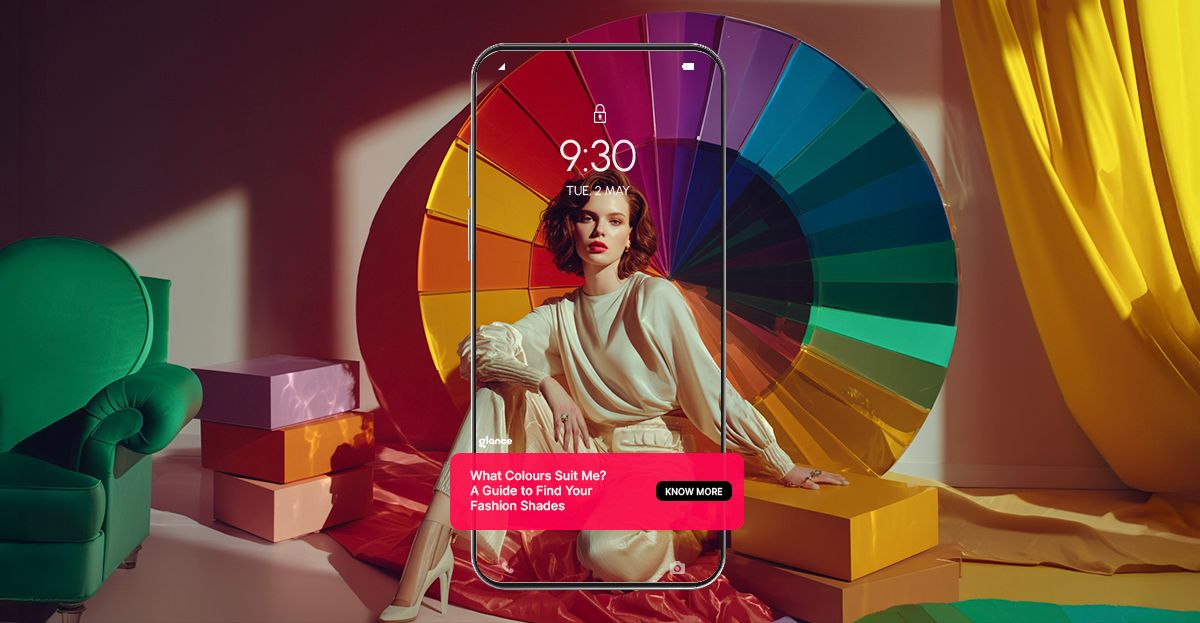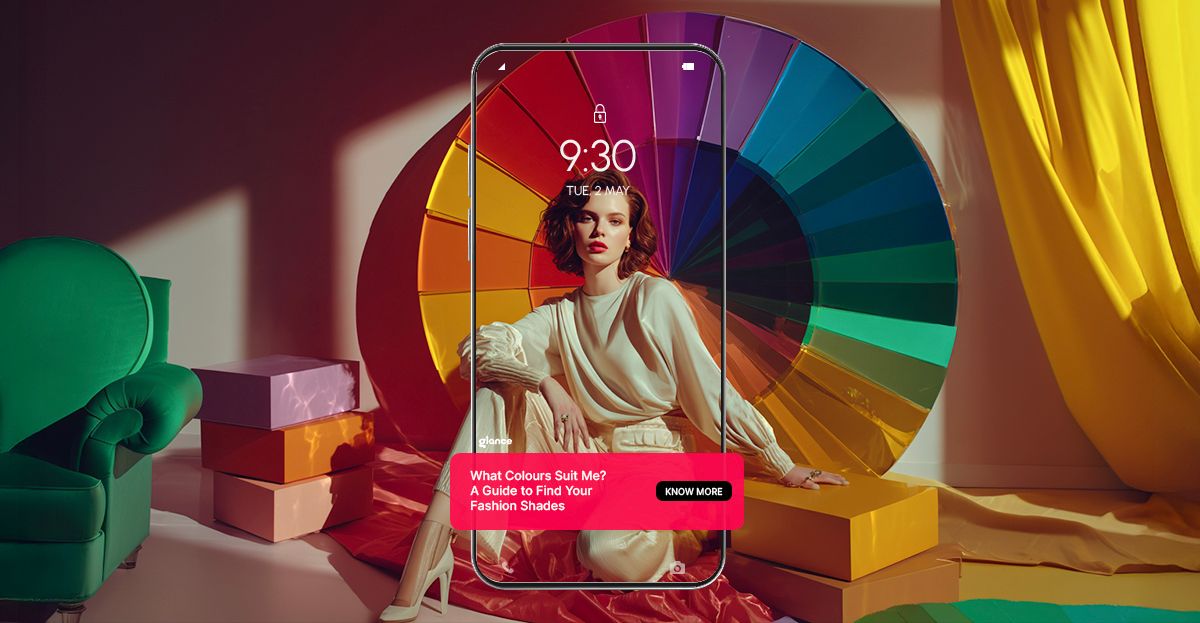How Fashion Inspiration Evolves Through Social Media
What Colours Suit Me? A Guide to Find Your Fashion Shades


Ever worn something that made you feel instantly confident—without knowing exactly why? That wasn’t just the cut, or the fabric types for fashion, , or even the brand. Chances are, it was the color. More specifically, it was the right color for your skin tone.
We all have colors that naturally enhance our complexion, and others that wash us out. But figuring out which ones work — and why — has traditionally been a mix of trial, error, and guesswork.
Until now.
In this article, we’ll answer the classic question: What colours suit me? We’ll explore:
- The science behind skin tone and undertone
- Common mistakes people make when choosing colors
- How Glance AI uses facial analysis to identify your personal palette
- Examples of flattering vs. clashing shades based on tone types
- Why digital twins and AI styling are changing the rules of personal color theory in fashion styling.
If you’ve ever stood in front of the mirror wondering why a certain outfit feels off — or tried to follow trends that don’t work for you — this guide will help you decode the color puzzle, with AI precision and fashion logic.
The Basics of Skin Tone and Undertone — What You Need to Know Before Choosing Colours

Before you can choose the colors that suit you, you need to understand what you’re working with. That starts with two things: skin tone and undertone. They sound similar — but they play very different roles in color matching for clothes.
Skin Tone vs. Undertone: What’s the Difference?
- Skin tone refers to the surface color of your skin — fair, light, medium, tan, deep, etc. It can change with sun exposure or skin conditions.
- Undertone is the subtle hue beneath your skin that doesn’t change. It determines how colors interact with your natural pigmentation.
There are three main undertone categories:
Undertone | How It Looks | Key Indicators |
Cool | Hints of pink, red, or blue | Veins look blue; silver jewelry suits better |
Warm | Hints of yellow, peach, or golden | Veins look green; gold jewelry looks natural |
Neutral | A mix of cool and warm hues | Veins are hard to distinguish; both silver and gold work |
Why Undertones Matter in Fashion
Color isn’t just visual — it’s reflective. The colors you wear bounce light onto your face, subtly affecting how your skin looks. The wrong tones can make you appear tired, washed out, or overly flushed. The right ones? They make your skin glow.
For example:
- Cool undertones thrive in jewel tones like emerald, sapphire, and ruby.
- Warm undertones shine in earth tones like mustard, rust, and olive.
- Neutral undertones can adapt to most palettes, especially soft tones and muted shades.
Knowing your undertone is like unlocking the cheat code to instantly looking more refreshed, balanced, and stylish — without changing your outfit silhouette.
But Here’s the Catch:
Most people misjudge their undertone — or oversimplify it. That’s where Glance AI steps in, replacing guesswork with data-backed skin analysis.
How Glance AI Determines Your Colour Profile?

Forget holding gold and silver jewelry up to your face or squinting at vein colors under daylight. Glance AI takes the complexity out of color analysis by using AI-powered facial recognition and skin tone mapping to determine your ideal palette — accurately, instantly, and without bias.
How It Works
Glance AI uses a combination of machine learning, color theory in fashion, and image processing to analyze your face and define your color compatibility. Here’s what the system reads:
- Surface Skin Tone
It categorizes your skin into one of several tone groups: very fair, fair, medium, olive, deep, or rich. - Undertone Detection
Using color calibration and light balancing, Glance identifies the dominant hues beneath the surface. Is your skin leaning pinkish-blue (cool), yellow-golden (warm), or a balanced mix (neutral)? - Contrast Ratio Analysis
Glance examines the contrast between your skin, hair, and eyes to determine whether high-contrast or soft-blend color schemes will flatter you most. - Environmental Adjustments
Glance factors in ambient lighting, camera quality, and even recent sun exposure to correct for misreads and refine accuracy. - Cultural Context + Personal Preferences
Depending on your region, the AI adapts color choices based on local symbolism, dress codes, and trend patterns — ensuring suggestions make cultural and aesthetic sense.
What You Receive
Once your color profile is determined, Glance generates:
- A personalized colour palette (primary, secondary, and accent tones)
- Do's and don’ts for clothing colors based on your profile
- Lookbooks featuring styles and shades tailored to your undertone, occasion, and mood
- Seamless shopping suggestions that already align with your ideal palette
The result: no more guesswork, no more fashion faux pas, and no more depending on filters to make your outfit “work.” You get colors that are designed to make you feel like you — on your best day.
What Colours Suit Each Undertone: Know with Glance AI
Once Glance AI determines your undertone, it doesn’t just tell you what you can wear — it shows you how to wear it with confidence. These are not generic rules pulled from a color wheel. They’re tailored recommendations based on real-time styling data, fashion color psychology, and how color performs on your unique skin tone.
Here’s how Glance AI breaks it down:
Cool Undertones

Skin appears pink, rosy, or bluish. Veins often look blue, and silver jewelry tends to flatter more than gold.
Glance-approved colors:
- Sapphire blue
- Emerald green
- Plum and raspberry
- Charcoal grey
- Icy pastels (lavender, powder blue)
Avoid: Mustard, terracotta, or overly warm browns — these can clash and make the skin look dull.
Example pairing:
A slate grey silk shirt + white trousers + a navy coat = crisp, clean, and contrast-friendly.
Warm Undertones

Skin has golden, peachy, or yellow hues. Veins may look green, and gold jewelry often compliments better than silver.
Glance-approved colors:
- Olive green
- Rust, camel, and burnt orange
- Warm reds (like tomato or coral)
- Mustard yellow
- Cream or off-white
Avoid: Cool greys, icy blues, or neon tones — they can wash you out.
Example pairing:
A rust linen button-down + cream chinos + brown leather loafers = grounded and glowing.
Neutral Undertones
Skin doesn’t lean too pink or golden — it’s a blend of both. Veins may appear blue-green, and both silver and gold tend to look fine.
Glance-approved colors:
- Soft blush, rose, or taupe
- Teal, pine, or true red
- Classic black or white
- Dusty blue or lavender
- Earth tones with balance (not too warm, not too cold)
Avoid: Extreme shades on either end (too neon or too muted).
Example pairing:
A teal cotton t-shirt + khaki chinos + light denim jacket = stylish, balanced, effortlessly modern.
What makes Glance AI’s suggestions different is that they don’t stop at what suits your undertone — they filter recommendations by where you're going, how you want to feel, and what the weather’s like.
The result? Style that works in real life, not just theory.
Conclusion
When you wear the right colours, it shows — not just on your skin, but in your energy. You feel sharper, more vibrant, more yourself. And that’s not about trends. It’s about alignment between your tone, your intent, and your environment.
That’s the beauty of Glance AI. It takes what used to be an educated guess — “What colours suit me?” — and turns it into personalized precision. By reading your skin tone, mapping your digital twin, and analyzing your emotional styling goals, Glance offers more than outfits. It delivers colour confidence.
You don’t need to learn the science of undertones. You just need to use an app that already has.
FAQs Related to What Colours Suit Me?
1. How do I know what colours suit me?
Your ideal colours depend on your skin tone and undertone. Cool undertones suit jewel tones, warm undertones shine in earth tones, and neutral undertones can wear a mix.
2. What are undertones and why do they matter in fashion?
Undertones are the subtle hues beneath your skin — cool (pink/blue), warm (yellow/golden), or neutral. They affect how colours reflect on your face. Wearing colours aligned with your undertone improves how fresh, bright, or balanced you look.
3. Can Glance AI really tell which colours suit me?
Yes. Glance AI uses image recognition, colour science, and machine learning to map your skin tone and undertone.
4. What if I have a neutral skin tone?
Neutral undertones are flexible. You can typically wear both warm and cool colours, especially muted or soft shades.
5. Does my skin tone affect how I should match colours in outfits?
Absolutely. The wrong colour can make you look washed out or tired. The right colour enhances your natural complexion.
6. Are there colours everyone can wear?
Some universal shades — like true red, teal, or soft blush — suit most undertones in the right fabric and cut. But even these benefit from personalization.






